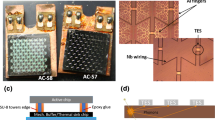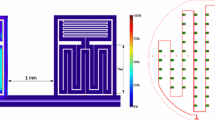Abstract
The necessity to increase exposure in rare event search experiments by maintaining a low energy threshold and a good energy resolution leads to segmented detectors as in EDELWEISS (Dark Matter), CUORE (0\(\nu \beta \beta\)) or Ricochet (CENNS) for example. However, the large number of sub-elements can dramatically increase the complexity of such detector arrays. In this work we report on our progress towards designing a flexible detector technology based on Kinetic Inductance Detector (KID) resonators evaporated on massive target crystals readout by a contact-less feedline. Providing that we achieve \(\mathcal {O}(100)\) eV energy threshold, such approach could easily be scaled to tens of kilogram detector arrays thanks to the intrinsic multiplexing capability of KIDs. Using a 30 g silicon target absorber with Al/Ti multi layers for the KID resonator, we report a significant improvement of our detector response exhibiting a keV-scale energy resolution combined with the absence of position dependence on the event location. Indeed, compared to our previous work, we are now able to properly identify calibration lines from surface (20 keV X-rays) and bulk events (60 keV gamma rays). This significant improvement is an important step towards a better understanding of phonons and quasiparticles dynamics, which is pivotal in optimizing this technology.






Similar content being viewed by others
Data Availability
The datasets generated during and/or analysed during the current study are available from the corresponding author on reasonable request.
References
L. Cardani, N. Casali, A. Cruciani, H. Le Sueur, M. Martinez, F. Bellini, M. Calvo, M. G. Castellano, I. Colantoni and C. Cosmelli, et al. Al/Ti/Al phonon-mediated KIDs for UV–vis light detection over large areas. Supercond. Sci. Technol. 31(7), 075002 (2018) https://doi.org/10.1088/1361-6668/aac1d4. arXiv:1801.08403 [physics.ins-det]
J. Colas et al., Development of data processing and analysis pipeline for the RICOCHET experiment J (Low Temp. Phys, This Special Issue, 2021)
M. Daal, B. Sadoulet, J. Gao, Kinetic inductance phonon sensors for the cryogenic dark matter search experiment. J. Low Temp. Phys. 151, 544–549 (2008). https://doi.org/10.1007/s10909-007-9689-y
S.A.H. de Rooij, J.J.A. Baselmans, V. Murugesan et al., Strong reduction of quasiparticle fluctuations in a superconductor due to decoupling of the quasiparticle number and lifetime. Phys. Rev. B 104, L180506 (2021). https://doi.org/10.1103/PhysRevB.104.L180506
J. Goupy, J. Colas, M. Calvo, J. Billard, P. Camus, R. Germond, A. Juillard, L. Vagneron, M. De Jesus and F. Levy-Bertrand, et al. Contact-less phonon detection with massive cryogenic absorbers. Appl. Phys. Lett. 115, no.22, 223506 (2019). https://doi.org/10.1063/1.5116405. arXiv:1906.10397 [physics.ins-det]
R. Maisonobe, J. Billard, M. De Jesus, A. Juillard, D. Misiak, E. Olivieri, S. Sayah and L. Vagneron, “Vibration decoupling system for massive bolometers in dry cryostats,” JINST 13, no. 08, T08009 (2018) https://doi.org/10.1088/1748-0221/13/08/T08009. arXiv:1803.03463 [physics.ins-det]
A. Monfardini, L. J. Swenson, A. Bideaud, et al. NIKA: a millimeter-wave kinetic inductance camera. Astron. Astrophys. 521, A29 (2010) https://doi.org/10.1051/0004-6361/201014727
S. Probst, F. B. Song, P. A. Bushev, A. V. Ustinov and M. Weides, Efficient and robust analysis of complex scattering data under noise in microwave resonators. Rev. Sci. Instrum. 86, 024706 (2015) https://doi.org/10.1063/1.4907935. arXiv:1410.3365 [cond-mat.supr-con]
Acknowledgements
This work is supported by the European Research Council (ERC) under the European Union’s Horizon 2020 research and innovation program under Grant Agreement ERC-StG-CENNS 803079.
Author information
Authors and Affiliations
Corresponding author
Additional information
Publisher's Note
Springer Nature remains neutral with regard to jurisdictional claims in published maps and institutional affiliations.
Rights and permissions
Springer Nature or its licensor (e.g. a society or other partner) holds exclusive rights to this article under a publishing agreement with the author(s) or other rightsholder(s); author self-archiving of the accepted manuscript version of this article is solely governed by the terms of such publishing agreement and applicable law.
About this article
Cite this article
Colas, J., Calvo, M., Goupy, J. et al. Improvement of Contact-Less KID Design Using Multilayered Al/Ti Material for Resonator. J Low Temp Phys 211, 281–288 (2023). https://doi.org/10.1007/s10909-023-02976-0
Received:
Accepted:
Published:
Issue Date:
DOI: https://doi.org/10.1007/s10909-023-02976-0




